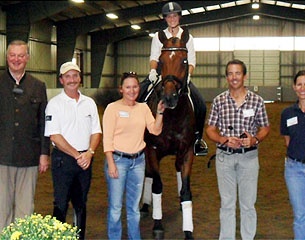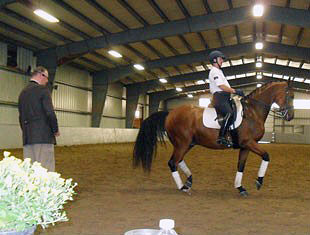
In the autumn of 2011 renowned German trainer Conrad Schumacher travelled to Drywater Farm in Stoughton, MA, U.S.A to teach the clinic "Learn the System and Teach with Skill" stressing positive training for riders. Influenced by his own longtime trainer and mentor, the late Josef Neckerman, Schumacher has created an approach to classical German dressage that any horse and rider combination can be successful with.
Basically, the classical German approach to dressage is based on the method of training that the German cavalry developed. The funding for the army horses was limited. Therefore, the German cavalry developed a system to keep the horses healthy and working for many years. By placing more weight on the haunches and lightening the forehand, the horses stayed sound for longer periods of time. As a consequence, the breeding of warmbloods changed. The training system demanded horses that accepted collection more easily. The fact that collection also elevated the forehand and the horse’s movement looked more beautiful was a side effect that was highly welcomed by riders and spectators, once dressage training turned into a sport after WWII.
After the war many of the cavalry officers, who were experts in horsemanship and training, were jobless and started teaching horses and riders in riding schools all over Germany. Additionally, the German Equestrian Federation began to transform the cavalry field manual into what is now known as the German principles of riding that constitute the German training system. Both the availability and the pedagogical calling of experts, who trained horses and people according to a single set of rules, and the German Equestrian Federation’s endeavor to systematize that set of rules explains why the classical German dressage system is still the dominant training method in Germany. The classical German dressage system consists of a training scale that starts with relaxation. Relaxation promotes the horse to move through his whole body and use it effectively. Thereby, it stays healthy and becomes a long-term competition partner. This is also the basis for Schumacher’s system.
Training with 'Feel'
In 1976, Schumacher started training young riders. Since then he has trained many winning combinations from Holland, Germany, England, Ireland, Israel and the United States. Like everyone else in his generation in Germany, Schumacher initially was taught how to ride by cavalry officers. They insisted that he never punishes a horse for the riding mistakes he made. That meant that he had to develop ‘feel’. When training young riders, it quickly became clear to him that it was that ‘feel’ that he wanted to teach. ‘Feel’ is something that cannot be explained easily, he realized, because each rider’s perception of what she feels is likely to differ from his own understanding of that feeling. For that reason, he developed a training approach and exercises that teach riders the ‘feel’ for balance and throughness. When using this ‘feel,’ the rider finds that the movements become less complicated and that the horses are able to stay relaxed even at the highest level of competition.
Many trainers have the desire to train horses without force and to keep them participating in the game. Schumacher works on the fundamentals in a systematic way, creating an atmosphere of participation and learning. In dressage, he says, the horses work hard physically and the rider must have mental fitness. Horses want to stay in their comfort zone, riders want to go to the Olympics. Therefore to have a system that keeps the horse fit, comfortable and eager will bring good results. If the horse is not in a good mood and does not cooperate with his rider there may be some short-term positive results, but never a long-term winning and truly successful partnership.
"So the basic German system is based on the training pyramid: Rhythm, Relaxation, Connection (contact), Impulsion, Straightness and Collection. If you understand this well and ride it correctly your horses stay sound and happy,” Schumacher teaches. ”On the basis of relaxation the horses are never stuck in their body and this means when the horse puts the feet on the ground the joints do not get uneven or wrong pressure. The horse moves in natural balance, the way it was born to move.”
Relaxation Through the Right Neck Position
 If relaxation is missing the horse becomes stuck in his own body. This happens because riders tend to have difficulties with the coordination of driving and restraining aids: They tend to hold on to the reins and then have to kick hard to make the horses go. Consequently, the horse’s back tightens and is restricted in its natural movement. Athletic horses are able to make up for the lack of balance with their legs. However, over time the joints in the horse’s legs take pressure they should not. Many people think they bought a weak horse, one that is not able to perform the job. But often it is the unbalanced riding that causes tension and even lameness.
If relaxation is missing the horse becomes stuck in his own body. This happens because riders tend to have difficulties with the coordination of driving and restraining aids: They tend to hold on to the reins and then have to kick hard to make the horses go. Consequently, the horse’s back tightens and is restricted in its natural movement. Athletic horses are able to make up for the lack of balance with their legs. However, over time the joints in the horse’s legs take pressure they should not. Many people think they bought a weak horse, one that is not able to perform the job. But often it is the unbalanced riding that causes tension and even lameness.
One of the basics of Schumacher’s theory, therefore, is neck position. "If you train a horse with the wrong neck position you will ride pressure into the horse, even if you do not mean too." Sooner or later things will go awry with a wrong neck position at the shows. Mistakes and tension will creep into tests. Eventually the horse will no longer want to do the job. Horses that are trained by force will not continue to be happy in their job when they are 18-20 years old. So through his training system he helps the rider to understand the ‘feel’ of a good neck position. It looks good because it is the result of the horse’s good balance and a freely moving back. By allowing the horse to have the correct neck position the rider herself sits more balanced and feels the horse’s balance with his/her body.
Schumacher’s encouraging way of teaching and thoughtful approach allow the rider to relax and to concentrate on feeling when it is right to ask or to give. His ability to make the rider comfortable and guide her also lets the horse relax. He is able to identify with someone who has learned to ride on a thoroughbred or an Arabian as well as on a warm-blood. And his experience of many different cultures has given him an encyclopedia of exercises and approaches. With Schumacher's training riders are able to create the strength in the horse to move up the levels, the desire in the horse to work for you and the understanding in the rider to put the basics to use, no matter what level she is showing. The system he teaches focuses on a fully functioning horse’s back and body and thereby keeps horses happy and sound for many years.
“It is fun to ride such a horse where the whole body functions, but it is also a way to make sure your horse has a long life,” says Schumacher. A good trainer is like a conductor bringing the pieces of the orchestra together into a harmony that is tangible. Once you’ve felt the ease with which your horse moves happily through the movements you do not want to do it any other way.
by Nancy Lavoie, edited by Eurodressage
Related Links
Conrad Schumacher clinics in Canada and the USA
Bartels Family Enthuses the Crowds at 2011 British Dressage Convention
Antoinette, Josef Neckermann's Prima Donna
Mariano, the First World Champion in Dressage